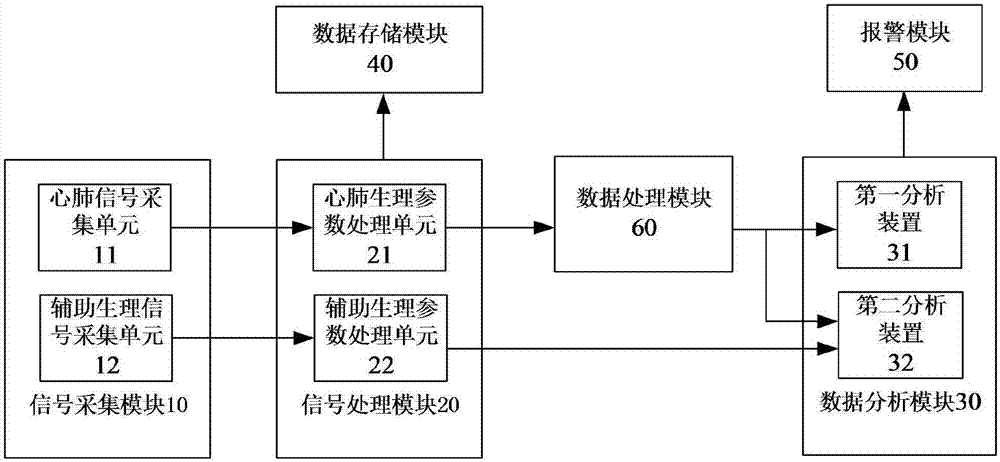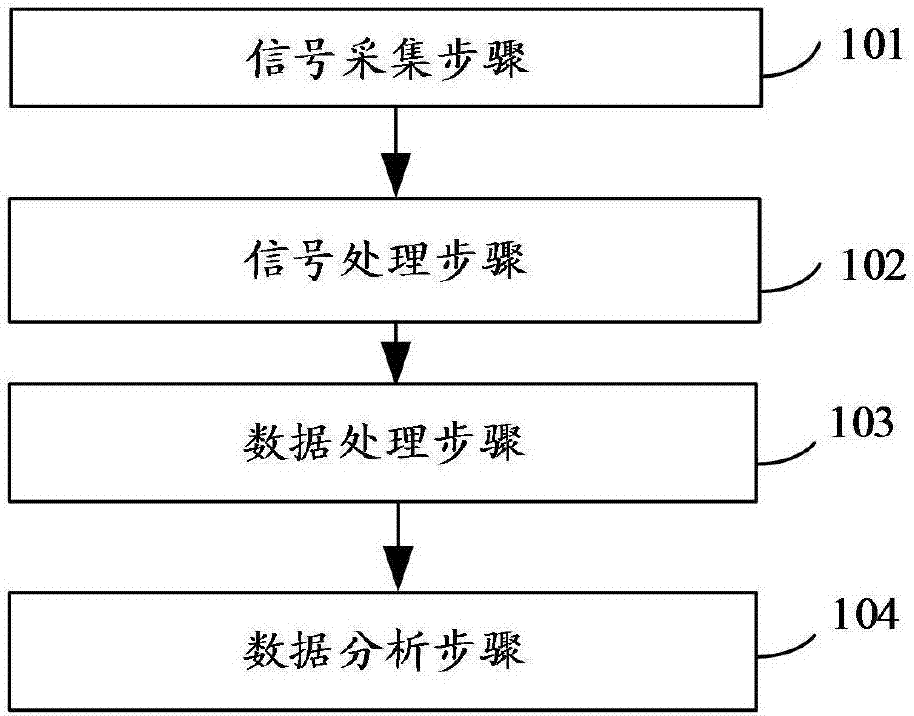Monitoring method and system for safe driving, automobile and readable storage medium
A technology for safe driving and data, applied in the measurement of pulse rate/heart rate, diagnostic record/measurement, medical science, etc., which can solve the problems of image recognition method detection accuracy easily affected by ambient light, low accuracy, and capture signal interference. , to reduce the amount of data processing, ensure driving safety, and reduce the difficulty of analysis
- Summary
- Abstract
- Description
- Claims
- Application Information
AI Technical Summary
Problems solved by technology
Method used
Image
Examples
Embodiment 1
[0068] Please refer to figure 1 , is a monitoring system for safe driving, the system includes: a signal acquisition module 10, a signal processing module 20, a data processing module 60 and a data analysis module 30, in some embodiments, also includes: a data storage module 40 and an alarm module 50, which will be explained in detail below.
[0069] The signal acquisition module 10 includes: a cardiopulmonary signal acquisition unit 11 and an auxiliary physiological signal acquisition unit 12 .
[0070] The cardiopulmonary signal collection unit 11 is used to collect ECG waveforms and respiratory waveforms, including: cardiopulmonary sensing electrodes for collecting cardiopulmonary activity potential signals, cardiopulmonary signal conditioning circuits and analog-to-digital conversion circuits for amplification and filtering.
[0071] The auxiliary signal acquisition unit 12 is used to collect body temperature, blood pressure, and blood oxygen signal waveforms, including: ...
Embodiment 2
[0099] refer to Figure 4 , is a data analysis method provided by the present application, and this method can be applied in step 103 of the first embodiment. The method includes:
[0100] Step 201, modeling: use HMM hidden Markov model to establish cardiac model X and respiratory model Y respectively; HMM hidden Markov model divides fatigue into four states: state I means normal, state II means mild fatigue , state III means moderately fatigued but alert, and state IV means drowsy.
[0101] Step 202, model training: select the cardiac interval sequence data of n time units of the sample to be tested as the observation value sequence Ox to train the cardiac model X, learn the cardiac model Y to obtain hidden Markov model parameters; select n time units of the sample to be tested The continuous respiration rate data is used as the observation value sequence Oy to train the respiration model Y, and learn the hidden Markov model parameters of the respiration model Y, and n is a...
Embodiment 3
[0119] refer to Image 6 , to provide another data analysis method for this application, and this method can be applied in step 103 of the first embodiment. The method includes:
[0120] Step 301, the first acquisition step: Obtain the cardiac interval sequence data of public samples from the public database, and select the cardiac interval sequence data of a large number of normal people, sub-healthy people, patients with related cardiovascular diseases and patients with myocardial infarction in the public Value, calculate the corresponding heart rate variability and heart rate deceleration force.
[0121] Step 302, the second acquisition step: obtain the cardiac interval sequence data of the sample to be tested for a period of m time units, and calculate its heart rate variability and heart rate deceleration force; the length of the cardiac interval sequence data of the public sample and the sample to be tested is the same, both are m time unit, m is a positive integer gre...
PUM
 Login to View More
Login to View More Abstract
Description
Claims
Application Information
 Login to View More
Login to View More - R&D
- Intellectual Property
- Life Sciences
- Materials
- Tech Scout
- Unparalleled Data Quality
- Higher Quality Content
- 60% Fewer Hallucinations
Browse by: Latest US Patents, China's latest patents, Technical Efficacy Thesaurus, Application Domain, Technology Topic, Popular Technical Reports.
© 2025 PatSnap. All rights reserved.Legal|Privacy policy|Modern Slavery Act Transparency Statement|Sitemap|About US| Contact US: help@patsnap.com



